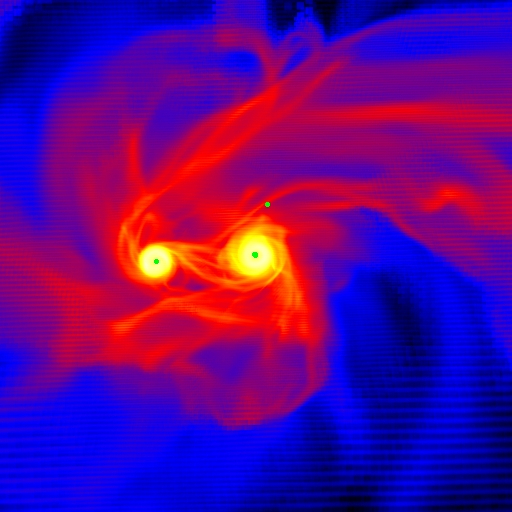
|
EPoS |
|
EPoS Contribution
|
|
Disk formation in turbulent cores: Circumventing the magnetic braking catastrophe
Daniel Seifried Hamburger Sternwarte, Hamburg, Germany | |
| In recent years numerous simulations of low- and high-mass star formation in strongly magnetized cloud cores have revealed the problem of so-called "magnetic braking catastrophe". This states that angular momentum removal due to the magnetic fields is so strong that the build up of Keplerian protostellar disks is largely inhibited for cores with magnetization in agreement with observations. Also the inclusion of non-ideal MHD effects fails to produce large scale (10 - 100 AU), rotationally supported disks. In our work we present collapse simulations of 100 M_sun, turbulent cloud cores threaded by a strong magnetic field (mass-to-flux ratio = 2.6). During the initial collapse phase filaments are generated which fragment quickly and form several protostars. Around these protostars Keplerian disks with typical sizes of a few 10 AU build up which is in contrast to previous simulations neglecting turbulence. We will discuss three mechanisms potentially responsible for reducing the magnetic braking efficiency and therefore allowing for the formation of the Keplerian disks. Analysing the condensations in which the discs form, we show that the build-up of Keplerian discs is neither caused by magnetic flux loss due to turbulent reconnection nor by the misalignment of the magnetic field and the angular momentum. The formation of Keplerian disks is rather a consequence of the turbulent surroundings of the disks which exhibit no signs of a large-scale, coherent rotation structure. We can show that in such a turbulent environment the magnetic braking efficiency is reduced while the inwards angular momentum transport remains high due to local shear flows. We have performed several simulations with different initial conditions each revealing similar results. Hence, we suggest that the "magnetic braking catastrophe" is a consequence of the idealized, non-turbulent initial conditions and that turbulence provides a natural and simple mechanism to circumvent this problem. | |
 | |
| Caption: Multiple, Keplerian disk formation in turbulent and strongly magnetized cloud cores. | |
| Collaborators: R. Banerjee, Hamburger Sternw., Germany R. Klessen, ITA Heidelberg, Germany R. Pudritz, McMaster U., Canada |
Key publication
|